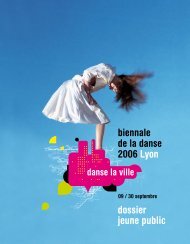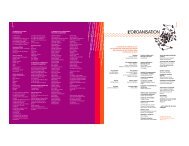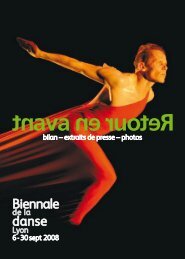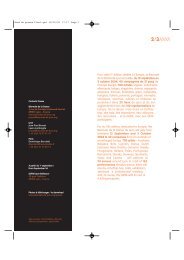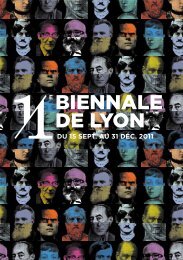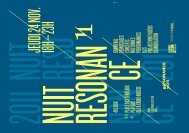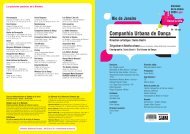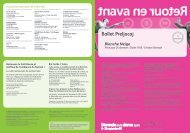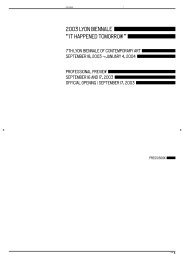Retour en Avant / Past Forward Biennale de la Danse Lyon - France
Retour en Avant / Past Forward Biennale de la Danse Lyon - France
Retour en Avant / Past Forward Biennale de la Danse Lyon - France
- No tags were found...
Create successful ePaper yourself
Turn your PDF publications into a flip-book with our unique Google optimized e-Paper software.
Vasant, inspiré par <strong>de</strong>s vers <strong>de</strong> Ritusambar,poème sanscrit écrit par Kalidas décrivantl’arrivée du printemps.Abhinaya, (danse expressive ou art <strong>de</strong> l’expression)sur le poème, ici, chanté <strong>de</strong> GitaGovinda, qui évoque les amours <strong>de</strong> Krishnaet Rhada, les <strong>de</strong>ux danseuses font appel à <strong>la</strong>mobilité du visage, <strong>de</strong>s yeux et <strong>de</strong>s mains.Sunsong, chorégraphie à <strong>la</strong> gloire du soleil,symbole <strong>de</strong> <strong>la</strong> consci<strong>en</strong>ce suprême et quireprés<strong>en</strong>te égalem<strong>en</strong>t <strong>la</strong> nature personnifiée<strong>de</strong> Dieu.Samanvaya, dans ce final, les spécificités <strong>de</strong>l’Odissi et du Bharatanatyam sont tissées <strong>en</strong>semblepour former une unique « tapisseriedansée ».Comm<strong>en</strong>t le passé peut-il définir le futur ?L’intime <strong>en</strong>tre<strong>la</strong>cem<strong>en</strong>t du passé et du prés<strong>en</strong>t estinhér<strong>en</strong>t à <strong>la</strong> p<strong>en</strong>sée indi<strong>en</strong>ne et notamm<strong>en</strong>t à <strong>la</strong> compréh<strong>en</strong>sion<strong>de</strong>s arts c<strong>la</strong>ssiques. Parampara, <strong>la</strong> tradition,désigne le changem<strong>en</strong>t ; elle est perçue comme unprocessus <strong>de</strong> croissance et d’évolution continu <strong>en</strong>racinédans le passé, qui <strong>de</strong>ssine le prés<strong>en</strong>t et s’ét<strong>en</strong>d versle futur. Car <strong>la</strong> tradition est intrinsèquem<strong>en</strong>t capabled’absorber et d’assimiler l’innovation. Les origines <strong>de</strong>mon style <strong>de</strong> danse, le Bharatanatyam, remont<strong>en</strong>t à aumoins <strong>de</strong>ux millénaires. Mais quand elle est interprétéepar <strong>de</strong>s danseurs créatifs, cette danse antique sedynamise, <strong>de</strong>vi<strong>en</strong>t une forme contemporaine évoluantsans cesse. Telle une rivière qui <strong>de</strong>sc<strong>en</strong>d du passélointain jusqu’au prés<strong>en</strong>t, cont<strong>en</strong>ue et ori<strong>en</strong>tée par lesrives <strong>de</strong> <strong>la</strong> tradition et <strong>de</strong> l’esthétique c<strong>la</strong>ssiques, maisdont le cours se modifie égalem<strong>en</strong>t pour accueillir d<strong>en</strong>ombreux afflu<strong>en</strong>ts porteurs <strong>de</strong> nouvelles idées etinspirations.Les formes que j’ai héritées <strong>de</strong> mes gourous <strong>de</strong> <strong>la</strong>dance et <strong>de</strong> <strong>la</strong> musique ne sont que les fon<strong>de</strong>m<strong>en</strong>tssur lesquels je construis <strong>de</strong>s structures dans l’espaceet le temps, à partir <strong>de</strong> mon expéri<strong>en</strong>ce personnelle<strong>de</strong> <strong>la</strong> danse, <strong>de</strong> <strong>la</strong> musique, <strong>de</strong> <strong>la</strong> littérature et <strong>de</strong> <strong>la</strong>vie. Ainsi, <strong>la</strong> danse s’<strong>en</strong> retrouve sans cesse <strong>en</strong>richie,r<strong>en</strong>ouvelée et vitalisée. Ma danse et ma vie prés<strong>en</strong>tessont <strong>de</strong>ssinées par <strong>la</strong> consci<strong>en</strong>ce collective du passé.A<strong>la</strong>rmel ValliInfos +Madhavi Mudgal invitée à <strong>la</strong> Bi<strong>en</strong>nale 2000www.a<strong>la</strong>rmelvalli.orgwww.artindia.netMadhavi MudgalShe grew up in the arts world: her fatherfoun<strong>de</strong>d Delhi’s leading school of Indian musicand dance, Gandharva Mahavidya<strong>la</strong>ya. Madhaviatt<strong>en</strong><strong>de</strong>d the school for several years, studyingBharatanatyam, Kathak and th<strong>en</strong> Odissi, before<strong>de</strong>ciding to <strong>de</strong>vote herself to the <strong>la</strong>tter style. Shegave her first performance at the age of four.Aged 11, she was s<strong>en</strong>t to East Germany andthe USSR as an Indian childr<strong>en</strong>’s ambassador. In1974, she received the special award bestowedby India’s national arts aca<strong>de</strong>my. Madhavi dancesall over the world, and takes part in India’sforemost festivals of music and dance. Hergrace, s<strong>en</strong>sibility and aesthetic imagination areparticu<strong>la</strong>rly sought-after and esteemed. Madhavihas taught at the International Sommeraka<strong>de</strong>mie<strong>de</strong>s Tanzes in Cologne, Germany, and at theInternational Mime aca<strong>de</strong>my in Vi<strong>en</strong>na, Austria.In India, she feels a duty to raise the profile ofher art and to pass it on: she teaches regu<strong>la</strong>rly atthe Gandharva Mahavidya<strong>la</strong>ya in Delhi and givesreading-cum-<strong>de</strong>monstrations.A<strong>la</strong>rmel ValliA<strong>la</strong>rmel Valli bases her dancing on the principlethat Bharatanatyam is a <strong>la</strong>nguage rich inimagery, and that a dancer who has masteredand interiorised this <strong>la</strong>nguage can write theirown “danced poem”. From the age of 16, sheabsorbed the teachings and choreographies ofher guru Shri Chockalingam Pil<strong>la</strong>i and of his sonSri Subbaraya Pil<strong>la</strong>i; and has since rolled backthe frontiers of tradition to incorporate her owncreativity. Her knowledge of the music and ofthe rich, nuanced vocabu<strong>la</strong>ry of c<strong>la</strong>ssical Indiandance has <strong>en</strong>abled A<strong>la</strong>rmel Valli to explore itsmultiple <strong>la</strong>yers of poetry, music and rhythms andto add a highly contemporary dim<strong>en</strong>sion. Shehas received many awards and distinctions.Samanvaya / 2004 créationFor Samanvaya, which in Sanscrit means “inunison”, Madhavi Mudgal and A<strong>la</strong>rmel Valli, twoof the most acc<strong>la</strong>imed c<strong>la</strong>ssical Indian dancers,teamed up for a shared creative experi<strong>en</strong>ce.They have absorbed the very rich choreographicvocabu<strong>la</strong>ry of the great Indian masters of Odissiand Bharatanatyam, while reinforcing theirtraining in c<strong>la</strong>ssical music. Their choreographicworks – in both the abstract and narrativeaspects of c<strong>la</strong>ssical Indian dance – stand out fortheir lyricism and instinctive musicality. Music,poetry, theatre, painting, sculpture and philosophyare c<strong>en</strong>tral to the <strong>la</strong>nguage of this art. Bothdancers and choreographers, A<strong>la</strong>rmel Valli andMadhavi Mudgal have interiorised this body <strong>la</strong>nguagein or<strong>de</strong>r to write their own danced poetry.Each of their pieces is thus a unique and <strong>de</strong>eplypersonal formu<strong>la</strong>tion.In Samanvaya, they have striv<strong>en</strong> to find commonground to articu<strong>la</strong>te their respective choreographies,searching for new dynamics whileretaining their specific styles. The linear andgeometric structure and the <strong>en</strong>ergy of Bharatanatyamare p<strong>la</strong>ced in the same setting as thes<strong>en</strong>sual and graceful lyricism and the constantswaying of the movem<strong>en</strong>ts of Odissi. Their differingtextures and nuances provi<strong>de</strong> a counterpoint,and height<strong>en</strong> the intrinsic characteristicsof each form.The two styles are based on distinctive musicaltraditions. Most of the pieces of music were<strong>de</strong>vised specially for this show. While somecompositions emphasise the specific featuresof Carnatic music (from Southern India) orHindustani music (from the North), for othersthe dancers worked with famous musicians suchas Madhup Mudgal and Prema Ramamoorthy inor<strong>de</strong>r to fuse musical styles and echo the “inunison” theme. Samanvaya features fourduets and two solos; the <strong>la</strong>tter wereconceived to provi<strong>de</strong> the foundationfor their joint work.Earth Hymn is inspired byverses of the Veda (the corpusof Indo-Aryan religious texts)and invoke the Earth, g<strong>en</strong>erousnurturer of natureand life.Nritta<strong>la</strong>hari, a form ofCarnatic music, wherethe dancers p<strong>la</strong>y with thediffer<strong>en</strong>ces and simi<strong>la</strong>ritiesof their styles.Vasant, inspired by versesfrom Ritusambar, a Sanscritpoem by Kalidas that<strong>de</strong>scribes the coming of spring.Abhinaya (expressive dance or art of expression)after the poem, here sung by Gita.Govinda, which re<strong>la</strong>tes the loves of Krishna andRhada; the two dancers exploit the mobility ofthe face, eyes and hands.Sunsong, a piece of choreography to the gloryof the sun, the symbol of supreme consciousnessand which also personifies God’s nature.Samanvaya: in this finale, the distinctive featuresof Odissi and of Bharatanatyam are interwov<strong>en</strong>to form a unique “danced tapestry”.How can the past shape the future?The close, interweaving of past and pres<strong>en</strong>t is intrinsicto Indian thought and to an un<strong>de</strong>rstanding of thec<strong>la</strong>ssical arts in particu<strong>la</strong>r. Parampara, or tradition, d<strong>en</strong>oteschange and is perceived as a continuous processof growth and evolution - that is rooted in the past,that shapes the pres<strong>en</strong>t and that reaches out towardsthe future. For, tradition has the inher<strong>en</strong>t capacity toabsorb and to assimi<strong>la</strong>te innovation. The origins ofmy dance style Bharatanatyam - go back at least twomill<strong>en</strong>nia. But wh<strong>en</strong> interpreted by creative dancers,this anci<strong>en</strong>t dance becomes a dynamic, continuouslyevolving contemporary form. It is like a river that hasflowed down from the distant past to the pres<strong>en</strong>t,contained within and gaining direction from the banksof c<strong>la</strong>ssical tradition and aesthetics, but also changingcourse, and accepting many tributaries of fresh i<strong>de</strong>asand new inspiration.The forms I inherited from my dance and music gurusare but the foundations on which I build structures,both in time and space, drawing from my individualexperi<strong>en</strong>ce of dance, music, literature and life. In theprocess, the dance is continuously <strong>en</strong>riched, r<strong>en</strong>ewedand vitalized. My dance and life in the pres<strong>en</strong>t areshaped by the collective consciousness of the past.A<strong>la</strong>rmel ValliExtra info:Madhavi Mudgal performed at the 2000Bi<strong>en</strong>nalewww.a<strong>la</strong>rmelvalli.orgwww.artindia.net31






